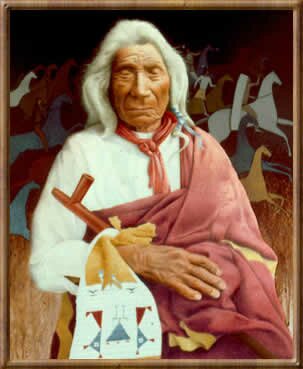Red Cloud
1822 - 1909

His name is derived from Siouan Makhpiya-luta, Scarlet Cloud (also Makhpia-sha, Red Cloud). He was a courageous nonhereditary Oglala Sioux chief at Pine Ridge, South Dakota who led his people in several important victories over the forces of the United States. He was born in Nebraska on September 20, 1822, near the Platte River to the distinguished Snake family; his father was Lone Man (Ishna Witca), and his mother was Walks as She Thinks, a Saone Teton. He had a twin brother, Roaring Cloud, also known as “Sky,” about whom almost nothing is known. The intelligence, strength, and bravery of Red Cloud became widely known throughout the tribe, and he was credited with 80 coups, or individual feats of bravery. He was eventually chosen as tribal chief over the hereditary claimant to the title, Young Man Afraid of His Horses.
His name has been the source of considerable controversy, and several “origins” are recorded. One account claims that his name came from the wave of red flannel blankets of his warriors sweeping over the Plains; a more likely source stems from the great red meteorite which is known to have struck the Plains region the day of his birth. Sioux winter counts record this event, and it is true that there were many babies named Red Cloud who were born that day.
The Oglala were the largest division of the Sioux Nation, and Red Cloud became perhaps the most important field commander among both Sioux and Cheyenne. He was strongly opposed to the westward expansion of the Whites, and believed that it was his mission to defend the Indians’ last and best hunting grounds. In the 1860s his warriors succeeded in virtually closing down the Bozeman Trail and other overland routes from Fort Laramie, Wyoming, and the east, to the Montana goldfields and the northwest. A peace conference was held at Fort Laramie in 1866, but when it became apparent that the United States intended to bring in more troops and expand their system of fortifications, Red Cloud stormed out of the meeting and took to the warpath. Soon afterwards, his forces surrounded the troops and laborers building Fort Phil Kearny, and skirmishes became a daily threat. In December, Captain William Fetterman foolishly pursued a band of Indians with a detachment of 80 soldiers, ran into an ambush, and he and his troops were annihilated.
Throughout 1867 the war of attrition continued, and not a single wagon moved along the trail to the goldfields. Finally, in 1868, the United States requested another peace council. In return for Red Cloud’s pledge to live in peace, the government promised to abandon all forts along the trail, and accept the territorial claims of the Sioux. However, Red Cloud stayed away until the last troops had actually been withdrawn and the forts were left standing unoccupied; only then did he sign the treaty at Fort Laramie on November 6, 1868. This event is frequently cited as one of the few times when Indian military power was able to force the United States to completely carry out the provisions of a peace treaty. Red Cloud kept his word, refusing to lead his younger men, impatient and hostile, when they demanded retaliatory action for the skirmishes which came in ever-increasing numbers. Two years later he headed a party of other Sioux leaders, visiting Washington and New York, to plead the Indians’ cause, asking why “Commissioners are sent out to us who do nothing but rob us.”
Although he was critical of the White representatives and of their continuing expansionism, he counseled peace during the troubles of 1876, when Crazy Horse, Gall, and Sitting Bull gathered their armies for battle. Five years later, Red Cloud was again on the offensive—this time demanding the removal of Indian Agent V. T. McGillicuddy. But times had changed, and this time the White man won. Red Cloud was removed as chief, and not long afterwards the tribe was removed to the Pine Ridge Reservation in South Dakota. Here, blind and ailing, he lived with his wife—contrary to usual Indian practice, he had married but once—in a house the government built for him until his death on December 10, 1909l
As a man, Red Cloud is described as being of tall, slender build, with courteous manners and quiet, yet firm, demeanor. He was highly respected by his people, and could claim equal rank with any contemporary general, statesman, or patriot in the country.
Source: Great North American Indians by Frederick J. Duckstander